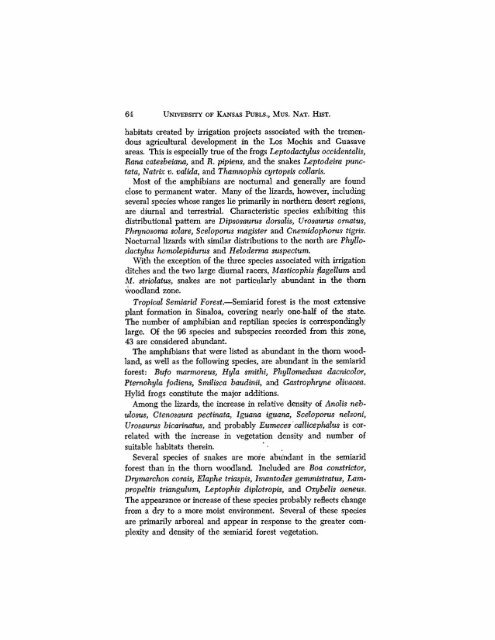The Amphibians and Reptiles of Sinaloa, Mexico - Smithsonian ...
The Amphibians and Reptiles of Sinaloa, Mexico - Smithsonian ...
The Amphibians and Reptiles of Sinaloa, Mexico - Smithsonian ...
Create successful ePaper yourself
Turn your PDF publications into a flip-book with our unique Google optimized e-Paper software.
64 UNIVERSITY OF KANSAS PUBLS., MUS, NAT. HIST.<br />
habitats created by irrigation projects associated with the tremendous<br />
agricultural development in the Los Mochis <strong>and</strong> Guasave<br />
areas. This is especially true <strong>of</strong> the frogs Leptodactylus occidentalis,<br />
Rana catesbeiana, <strong>and</strong> R. pipiens, <strong>and</strong> the snakes Leptodeira punctata,<br />
Natrix v. valida, <strong>and</strong> Thamnophis cyrtopsis collans.<br />
Most <strong>of</strong> the amphibians are nocturnal <strong>and</strong> generally are found<br />
close to permanent water. Many <strong>of</strong> the lizards, however, including<br />
several species whose ranges he primarily in northern desert regions,<br />
are diurnal <strong>and</strong> terrestrial. Characteristic species exhibiting this<br />
distributional pattern are Dipsosaurus dorsalis, Urosaurus ornatus,<br />
Phrynosoma solare, Sceloporus magister <strong>and</strong> Cnemidophorus tigris.<br />
Nocturnal lizards with similar distributions to the north are Pkyllodactylus<br />
homolepidurus <strong>and</strong> Heloderma suspectum.<br />
With the exception <strong>of</strong> the three species associated with irrigation<br />
ditches <strong>and</strong> the two large diurnal racers, Masticophis ftagellum <strong>and</strong><br />
M. striolatus, snakes are not particularly abundant in the thorn<br />
woodl<strong>and</strong> zone.<br />
Tropical Semiarid Forest.—Semiarid forest is the most extensive<br />
plant formation in <strong>Sinaloa</strong>, covering nearly one-half <strong>of</strong> the state.<br />
<strong>The</strong> number <strong>of</strong> amphibian <strong>and</strong> reptilian species is correspondingly<br />
large. Of the 96 species <strong>and</strong> subspecies recorded from this zone,<br />
43 are considered abundant.<br />
<strong>The</strong> amphibians that were listed as abundant in the thorn woodl<strong>and</strong>,<br />
as well as the following species, are abundant in the semiarid<br />
forest: Bufo marmoreus, Hyla smithi, Phyllomedusa dacnicolor,<br />
Pternohyla fodiens, Smilisca baudinii, <strong>and</strong> Gastrophryne olivacea.<br />
Hylid frogs constitute the major additions.<br />
Among the lizards, the increase in relative density <strong>of</strong> Anolis nebulosus,<br />
Ctenosaura pectinata, Iguana iguana, Sceloporus nelsoni,<br />
Urosaurus bicarinatus, <strong>and</strong> probably Eumeces callicephalus is correlated<br />
with the increase in vegetation density <strong>and</strong> number <strong>of</strong><br />
suitable habitats therein.<br />
Several species <strong>of</strong> snakes are more abundant in the semiarid<br />
forest than in the thorn woodl<strong>and</strong>. Included are Boa constrictor,<br />
Drymarchon corais, Elaphe triaspis, Imantodes gemmistratus, Lampropeltis<br />
triangulum, Leptophis diplotropis, <strong>and</strong> Oxybelis aeneus.<br />
<strong>The</strong> appearance or increase <strong>of</strong> these species probably reflects change<br />
from a dry to a more moist environment. Several <strong>of</strong> these species<br />
are primarily arboreal <strong>and</strong> appear in response to the greater complexity<br />
<strong>and</strong> density <strong>of</strong> the semiarid forest vegetation.
















